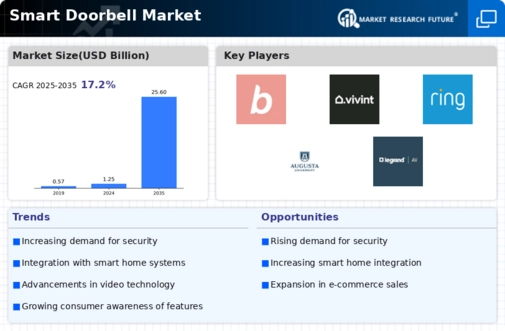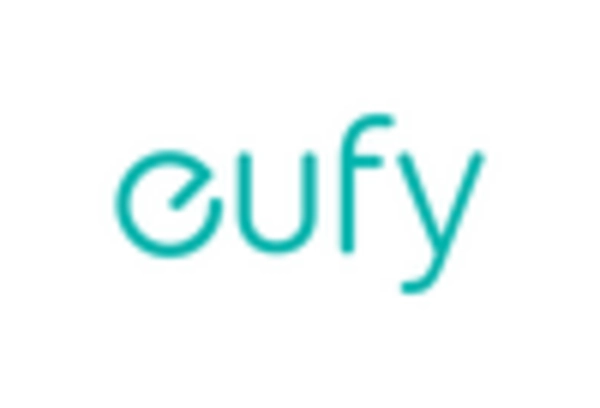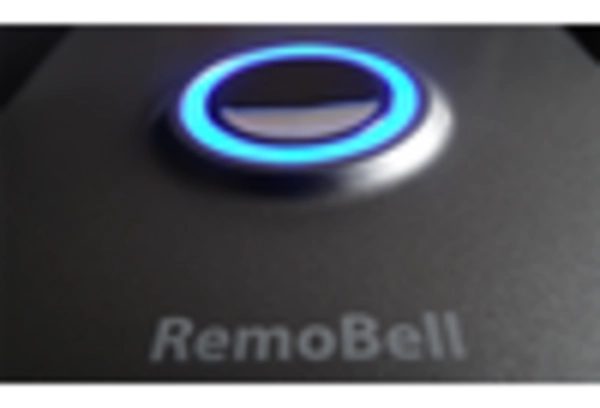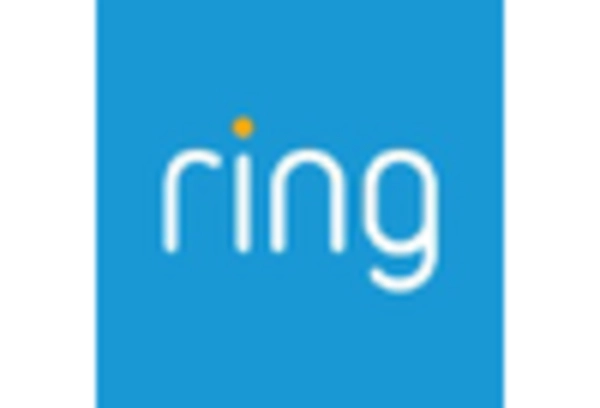-
EXECUTIVE SUMMARY
-
Market Attractiveness Analysis
- Global Smart Doorbell Market, by Type
- Global Smart Doorbell Market, by Component
- Global Smart Doorbell Market, by End-User
- Global Smart Doorbell Market, by Sales Channel
- Global Smart Doorbell Market, by Region
-
MARKET INTRODUCTION
-
Definition
-
Scope of the Study
-
Market Structure
-
Key Buying Criteria
-
Macro Factor Indicator Analysis
-
RESEARCH METHODOLOGY
-
Research Process
-
Primary Research
-
Secondary Research
-
Market Size Estimation
-
Forecast Component
-
List of Assumptions
-
MARKET DYNAMICS
-
Introduction
-
Drivers
-
Restraints
-
Opportunities
-
Challenges
-
MARKET FACTOR ANALYSIS
-
Value Chain Analysis/Supply Chain Analysis
-
Porter’s Five Forces Component
- Bargaining Power of Suppliers
- Bargaining Power of Buyers
- Threat of New Entrants
- Threat of Substitutes
- Intensity of Rivalry
-
GLOBAL SMART DOORBELL MARKET, BY TYPE
-
Introduction
-
Wired Doorbells
- Wired Doorbells: Market Estimates & Forecast, 2024-2032
-
Wireless Doorbells
- Wireless Doorbells: Market Estimates & Forecast, 2024-2032
-
GLOBAL SMART DOORBELL MARKET, BY COMPONENT
-
Introduction
-
Hardware
- Hardware: Market Estimates & Forecast, 2024-2032
-
Software
- Software: Market Estimates & Forecast, 2024-2032
-
GLOBAL SMART DOORBELL MARKET, BY END-USER
-
Introduction
-
Residential
- Residential: Market Estimates & Forecast, 2024-2032
-
Commercial
- Commercial: Market Estimates & Forecast, 2024-2032
-
GLOBAL SMART DOORBELL MARKET, BY SALES CHANNEL
-
Introduction
-
Store-Based
- Store-Based: Market Estimates & Forecast, 2024-2032
-
Non-Store Based
- Non-Store Based: Market Estimates & Forecast, 2024-2032
-
GLOBAL SMART DOORBELL MARKET, BY REGION
-
Introduction
-
North America
- Market Estimates & Forecast, by Type, 2024-2032
- Market Estimates & Forecast, by Component, 2024-2032
- Market Estimates & Forecast, by End-User, 2024-2032
- Market Estimates & Forecast, by Sales Channel, 2024-2032
- Market Estimates & Forecast, by Country, 2024-2032
-
Europe
- Market Estimates & Forecast, by Type, 2024-2032
- Market Estimates & Forecast, by Component, 2024-2032
- Market Estimates & Forecast, by End-User, 2024-2032
- Market Estimates & Forecast, by Sales Channel, 2024-2032
- Market Estimates & Forecast, by Country, 2024-2032
-
Asia-Pacific
- Market Estimates & Forecast, by Type, 2024-2032
- Market Estimates & Forecast, by Component, 2024-2032
- Market Estimates & Forecast, by End-User, 2024-2032
- Market Estimates & Forecast, by Sales Channel, 2024-2032
- Market Estimates & Forecast, by Country, 2024-2032
- China
- India
- Japan
- South Korea
- Rest of Asia-Pacific
-
Rest of the World
- Market Estimates & Forecast, by Type, 2024-2032
- Market Estimates & Forecast, by Component, 2024-2032
- Market Estimates & Forecast, by End-User, 2024-2032
- Market Estimates & Forecast, by Sales Channel, 2024-2032
- Market Estimates & Forecast, by Region, 2024-2032
- Middle East & Africa
- Central & South America
-
COMPETITIVE LANDSCAPE
-
Introduction
-
Competitive Analysis
-
COMPANY PROFILES
-
Panasonic Corporation
- Company Overview
- Financial Overview
- Components Offered
- Key Developments
- SWOT Analysis
- Key Strategies
-
Shenzhen VStarcam Technology Co., Ltd
- Company Overview
- Financial Overview
- Components Offered
- Key Developments
- SWOT Analysis
- Key Strategies
-
Ring Inc.
- Company Overview
- Financial Overview
- Components Offered
- Key Developments
- SWOT Analysis
- Key Strategies
-
SkyBell Technologies Inc.
- Company Overview
- Financial Overview
- Components Offered
- Key Developments
- SWOT Analysis
- Key Strategies
-
dbell Inc.
- Company Overview
- Financial Overview
- Components Offered
- Key Developments
- SWOT Analysis
- Key Strategies
-
August, Inc.
- Company Overview
- Financial Overview
- Components Offered
- Key Developments
- SWOT Analysis
- Key Strategies
-
SkyBell Technologies, Inc.
- Company Overview
- Financial Overview
- Components Offered
- Key Developments
- SWOT Analysis
- Key Strategies
-
Chui
- Company Overview
- Financial Overview
- Components Offered
- Key Developments
- SWOT Analysis
- Key Strategies
-
Dnake (XIAMEN) Intelligent Technology Co., Ltd.
- Company Overview
- Financial Overview
- Components Offered
- Key Developments
- SWOT Analysis
- Key Strategies
-
Smartwares Group (Byron)
- Company Overview
- Financial Overview
- Components Offered
- Key Developments
- SWOT Analysis
- Key Strategies
-
Legrand (Netatmo)
- Company Overview
- Financial Overview
- Components Offered
- Key Developments
- SWOT Analysis
- Key Strategies
-
Arlo Technologies, Inc.
- Company Overview
- Financial Overview
- Components Offered
- Key Developments
- SWOT Analysis
- Key Strategies
-
-
List of Tables
-
MARKET SYNOPSIS
-
LIST OF ASSUMPTIONS
-
GLOBAL SMART DOORBELL MARKET, BY COMPONENT, 2024-2032 (USD MILLION)
-
GLOBAL SMART DOORBELL MARKET, BY TYPE, 2024-2032 (USD MILLION)
-
GLOBAL SMART DOORBELL MARKET, BY END-USER, 2024-2032 (USD MILLION)
-
GLOBAL SMART DOORBELL MARKET, BY SALES CHANNEL, 2024-2032 (USD MILLION)
-
GLOBAL SMART DOORBELL MARKET, BY REGION, 2024-2032 (USD MILLION)
-
NORTH AMERICA: SMART DOORBELL MARKET, BY COUNTRY, 2024-2032 (USD MILLION)
-
NORTH AMERICA: SMART DOORBELL MARKET, BY COMPONENT, 2024-2032 (USD MILLION)
-
NORTH AMERICA: SMART DOORBELL MARKET, BY TYPE, 2024-2032 (USD MILLION)
-
NORTH AMERICA: SMART DOORBELL MARKET, BY END-USER, 2024-2032 (USD MILLION)
-
NORTH AMERICA: SMART DOORBELL MARKET, BY SALES CHANNEL, 2024-2032 (USD MILLION)
-
US: SMART DOORBELL MARKET, BY COMPONENT, 2024-2032 (USD MILLION)
-
US: SMART DOORBELL MARKET, BY TYPE, 2024-2032 (USD MILLION)
-
US: SMART DOORBELL MARKET, BY END-USER, 2024-2032 (USD MILLION)
-
US: SMART DOORBELL MARKET, BY SALES CHANNEL, 2024-2032 (USD MILLION)
-
CANADA: SMART DOORBELL MARKET, BY COMPONENT, 2024-2032 (USD MILLION)
-
CANADA: SMART DOORBELL MARKET, BY TYPE, 2024-2032 (USD MILLION)
-
CANADA: SMART DOORBELL MARKET, BY END-USER, 2024-2032 (USD MILLION)
-
CANADA: SMART DOORBELL MARKET, BY SALES CHANNEL, 2024-2032 (USD MILLION)
-
MEXICO: SMART DOORBELL MARKET, BY COMPONENT, 2024-2032 (USD MILLION)
-
MEXICO: SMART DOORBELL MARKET, BY TYPE, 2024-2032 (USD MILLION)
-
MEXICO: SMART DOORBELL MARKET, BY END-USER, 2024-2032 (USD MILLION)
-
MEXICO: SMART DOORBELL MARKET, BY SALES CHANNEL, 2024-2032 (USD MILLION)
-
EUROPE: SMART DOORBELL MARKET, BY COUNTRY, 2024-2032 (USD MILLION)
-
EUROPE: SMART DOORBELL MARKET, BY COMPONENT, 2024-2032 (USD MILLION)
-
EUROPE: SMART DOORBELL MARKET, BY TYPE, 2024-2032 (USD MILLION)
-
EUROPE: SMART DOORBELL MARKET, BY END-USER, 2024-2032 (USD MILLION)
-
EUROPE: SMART DOORBELL MARKET, BY SALES CHANNEL, 2024-2032 (USD MILLION)
-
UK: SMART DOORBELL MARKET, BY COMPONENT, 2024-2032 (USD MILLION)
-
UK: SMART DOORBELL MARKET, BY TYPE, 2024-2032 (USD MILLION)
-
UK: SMART DOORBELL MARKET, BY END-USER, 2024-2032 (USD MILLION)
-
UK: SMART DOORBELL MARKET, BY SALES CHANNEL, 2024-2032 (USD MILLION)
-
GERMANY: SMART DOORBELL MARKET, BY COMPONENT, 2024-2032 (USD MILLION)
-
GERMANY: SMART DOORBELL MARKET, BY TYPE, 2024-2032 (USD MILLION)
-
GERMANY: SMART DOORBELL MARKET, BY END-USER, 2024-2032 (USD MILLION)
-
GERMANY: SMART DOORBELL MARKET, BY SALES CHANNEL, 2024-2032 (USD MILLION)
-
FRANCE: SMART DOORBELL MARKET, BY COMPONENT, 2024-2032 (USD MILLION)
-
FRANCE: SMART DOORBELL MARKET, BY TYPE, 2024-2032 (USD MILLION)
-
FRANCE: SMART DOORBELL MARKET, BY END-USER, 2024-2032 (USD MILLION)
-
FRANCE: SMART DOORBELL MARKET, BY SALES CHANNEL, 2024-2032 (USD MILLION)
-
REST OF EUROPE: SMART DOORBELL MARKET, BY COMPONENT, 2024-2032 (USD MILLION)
-
REST OF EUROPE: SMART DOORBELL MARKET, BY TYPE, 2024-2032 (USD MILLION)
-
REST OF EUROPE: SMART DOORBELL MARKET, BY END-USER, 2024-2032 (USD MILLION)
-
REST OF EUROPE: SMART DOORBELL MARKET, BY SALES CHANNEL, 2024-2032 (USD MILLION)
-
ASIA-PACIFIC: SMART DOORBELL MARKET, BY COUNTRY, 2024-2032 (USD MILLION)
-
ASIA-PACIFIC: SMART DOORBELL MARKET, BY COMPONENT, 2024-2032 (USD MILLION)
-
ASIA-PACIFIC: SMART DOORBELL MARKET, BY TYPE, 2024-2032 (USD MILLION)
-
ASIA-PACIFIC: SMART DOORBELL MARKET, BY END-USER, 2024-2032 (USD MILLION)
-
ASIA-PACIFIC: SMART DOORBELL MARKET, BY SALES CHANNEL, 2024-2032 (USD MILLION)
-
CHINA: SMART DOORBELL MARKET, BY COMPONENT, 2024-2032 (USD MILLION)
-
CHINA: SMART DOORBELL MARKET, BY TYPE, 2024-2032 (USD MILLION)
-
CHINA: SMART DOORBELL MARKET, BY END-USER, 2024-2032 (USD MILLION)
-
CHINA: SMART DOORBELL MARKET, BY SALES CHANNEL, 2024-2032 (USD MILLION)
-
JAPAN: SMART DOORBELL MARKET, BY COMPONENT, 2024-2032 (USD MILLION)
-
JAPAN: SMART DOORBELL MARKET, BY TYPE, 2024-2032 (USD MILLION)
-
JAPAN: SMART DOORBELL MARKET, BY END-USER, 2024-2032 (USD MILLION)
-
JAPAN: SMART DOORBELL MARKET, BY SALES CHANNEL, 2024-2032 (USD MILLION)
-
INDIA: SMART DOORBELL MARKET, BY COMPONENT, 2024-2032 (USD MILLION)
-
INDIA: SMART DOORBELL MARKET, BY TYPE, 2024-2032 (USD MILLION)
-
INDIA: SMART DOORBELL MARKET, BY END-USER, 2024-2032 (USD MILLION)
-
INDIA: SMART DOORBELL MARKET, BY SALES CHANNEL, 2024-2032 (USD MILLION)
-
SOUTH KOREA: SMART DOORBELL MARKET, BY COMPONENT, 2024-2032 (USD MILLION)
-
SOUTH KOREA: SMART DOORBELL MARKET, BY TYPE, 2024-2032 (USD MILLION)
-
SOUTH KOREA: SMART DOORBELL MARKET, BY END-USER, 2024-2032 (USD MILLION)
-
SOUTH KOREA: SMART DOORBELL MARKET, BY SALES CHANNEL, 2024-2032 (USD MILLION)
-
REST OF ASIA-PACIFIC: SMART DOORBELL MARKET, BY COMPONENT, 2024-2032 (USD MILLION)
-
REST OF ASIA-PACIFIC: SMART DOORBELL MARKET, BY TYPE, 2024-2032 (USD MILLION)
-
REST OF ASIA-PACIFIC: SMART DOORBELL MARKET, BY END-USER, 2024-2032 (USD MILLION)
-
REST OF ASIA-PACIFIC: SMART DOORBELL MARKET, BY SALES CHANNEL, 2024-2032 (USD MILLION)
-
REST OF THE WORLD: SMART DOORBELL MARKET, BY COUNTRY, 2024-2032 (USD MILLION)
-
REST OF THE WORLD: SMART DOORBELL MARKET, BY COMPONENT, 2024-2032 (USD MILLION)
-
REST OF THE WORLD: SMART DOORBELL MARKET, BY TYPE, 2024-2032 (USD MILLION)
-
REST OF THE WORLD: SMART DOORBELL MARKET, BY END-USER, 2024-2032 (USD MILLION)
-
REST OF THE WORLD: SMART DOORBELL MARKET, BY SALES CHANNEL, 2024-2032 (USD MILLION)
-
MIDDLE EAST & AFRICA: SMART DOORBELL MARKET, BY COMPONENT, 2024-2032 (USD MILLION)
-
MIDDLE EAST & AFRICA: SMART DOORBELL MARKET, BY TYPE, 2024-2032 (USD MILLION)
-
MIDDLE EAST & AFRICA: SMART DOORBELL MARKET, BY END-USER, 2024-2032 (USD MILLION)
-
MIDDLE EAST & AFRICA: SMART DOORBELL MARKET, BY SALES CHANNEL, 2024-2032 (USD MILLION)
-
CENTRAL & SOUTH AMERICA: SMART DOORBELL MARKET, BY COMPONENT, 2024-2032 (USD MILLION)
-
CENTRAL & SOUTH AMERICA: SMART DOORBELL MARKET, BY TYPE, 2024-2032 (USD MILLION)
-
CENTRAL & SOUTH AMERICA: SMART DOORBELL MARKET, BY END-USER, 2024-2032 (USD MILLION)
-
CENTRAL & SOUTH AMERICA: SMART DOORBELL MARKET, BY SALES CHANNEL, 2024-2032 (USD MILLION)
-
List of Figures
-
GLOBAL SMART DOORBELL MARKET: MARKET STRUCTURE
-
TOP-DOWN & BOTTOM-UP APPROACHES
-
MARKET DYNAMICS ANALYSIS OF THE GLOBAL SMART DOORBELL MARKET
-
VALUE CHAIN ANALYSIS OF THE GLOBAL SMART DOORBELL MARKET
-
PORTER'S FIVE FORCES ANALYSIS OF THE GLOBAL SMART DOORBELL MARKET
-
GLOBAL SMART DOORBELL MARKET, BY TYPE, 2024-2032 (USD MILLION)
-
GLOBAL SMART DOORBELL MARKET, BY COMPONENT, 2024-2032 (USD MILLION)
-
GLOBAL SMART DOORBELL MARKET, BY END-USER, 2024-2032 (USD MILLION)
-
GLOBAL SMART DOORBELL MARKET, BY SALES CHANNEL, 2024-2032 (USD MILLION)
-
GLOBAL SMART DOORBELL MARKET, BY REGION, 2024-2032 (USD MILLION)
-
NORTH AMERICA: SMART DOORBELL MARKET, BY COUNTRY, 2024-2032 (USD MILLION)
-
NORTH AMERICA: SMART DOORBELL MARKET, BY TYPE, 2024-2032 (USD MILLION)
-
NORTH AMERICA: SMART DOORBELL MARKET, BY COMPONENT, 2024-2032 (USD MILLION)
-
NORTH AMERICA: SMART DOORBELL MARKET, BY END-USER, 2024-2032 (USD MILLION)
-
NORTH AMERICA: SMART DOORBELL MARKET, BY SALES CHANNEL, 2024-2032 (USD MILLION)
-
EUROPE: SMART DOORBELL MARKET, BY COUNTRY, 2024-2032 (USD MILLION)
-
EUROPE: SMART DOORBELL MARKET, BY TYPE, 2024-2032 (USD MILLION)
-
EUROPE: SMART DOORBELL MARKET, BY COMPONENT, 2024-2032 (USD MILLION)
-
EUROPE: SMART DOORBELL MARKET, BY END-USER, 2024-2032 (USD MILLION)
-
EUROPE: SMART DOORBELL MARKET, BY SALES CHANNEL, 2024-2032 (USD MILLION)
-
ASIA-PACIFIC: SMART DOORBELL MARKET, BY COUNTRY, 2024-2032 (USD MILLION)
-
ASIA-PACIFIC: SMART DOORBELL MARKET, BY TYPE, 2024-2032 (USD MILLION)
-
ASIA-PACIFIC: SMART DOORBELL MARKET, BY COMPONENT, 2024-2032 (USD MILLION)
-
ASIA-PACIFIC: SMART DOORBELL MARKET, BY END-USER, 2024-2032 (USD MILLION)
-
ASIA-PACIFIC: SMART DOORBELL MARKET, BY SALES CHANNEL, 2024-2032 (USD MILLION)
-
REST OF THE WORLD: SMART DOORBELL MARKET, BY COUNTRY, 2024-2032 (USD MILLION)
-
REST OF THE WORLD: SMART DOORBELL MARKET, BY TYPE, 2024-2032 (USD MILLION)
-
REST OF THE WORLD: SMART DOORBELL MARKET, BY COMPONENT, 2024-2032 (USD MILLION)
-
REST OF THE WORLD: SMART DOORBELL MARKET, BY END-USER, 2024-2032 (USD MILLION)
-
REST OF THE WORLD: SMART DOORBELL MARKET, BY SALES CHANNEL, 2024-2032 (USD MILLION)
-
TOP 10 PLAYERS MARKET SHARE ANALYSIS, BY REVENUE 2020 (%)
-
COMPETITIVE BENCHMARKING
















Leave a Comment